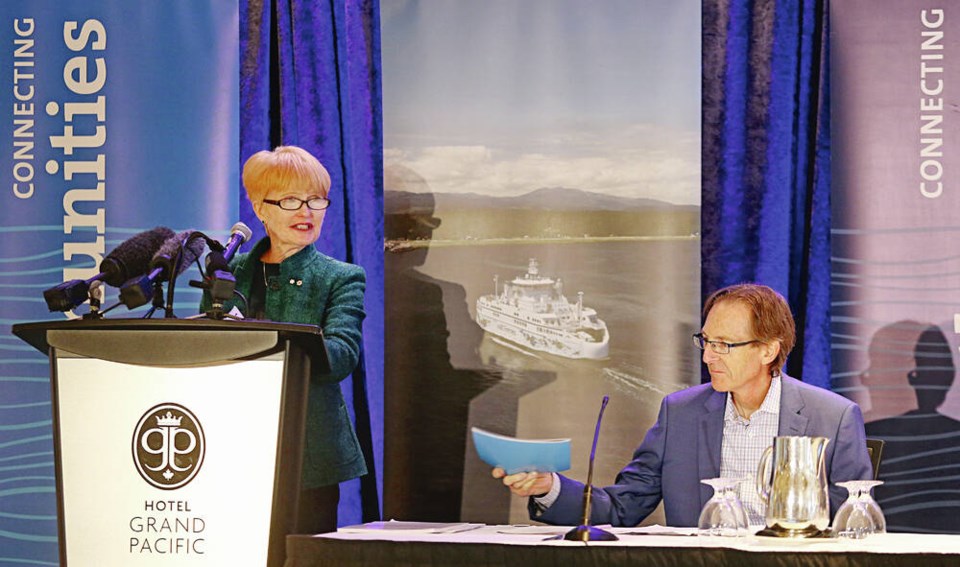B.C. Ferries wrapped up its past fiscal year, which ended March 31, by carrying a record 9.4 million vehicles, and then set another high in this year’s first quarter, April to June, with 2.5 million vehicles.
The numbers illustrate the strong demand from travellers as B.C. Ferries faces challenges, such as cancelled sailings, delayed departures and long waits at terminals, and as it looks to renew its fleet and infrastructure with a $5.2-billion capital plan.
B.C. Ferries’ annual general meeting in Victoria on Thursday highlighted issues such as the impact of global inflation, a worldwide shortage of trained mariners, changing patterns in the workplace, and workers tempted by higher wages offered by other employers. Negotiations are taking place now under an agreement to reopen wage talks.
The past fiscal year saw 21.6 million passengers ride the ferries, which was close to a record.
But amid rising demand, thousands of customers lost bookings in recent weeks when first Coastal Celebration and now Coastal Renaissance went out of service with mechanical problems.
Engine problems sidelined Coastal Renaissance, which is likely out of service until at least mid-October.
On Wednesday, the third of the three Coastal-class vessels, Coastal Inspiration, was delayed because of what the company called a minor issue. Service was normal on Thursday.
The German-built Coastal-class vessels are critical to the system, especially during the summer. They run between ┬щ╢╣┤л├╜╙│╗нIsland and the Lower Mainland, each one capable of carrying 1,604 passengers and crew and 310 cars.
Nicolas Jimenez, B.C. Ferries president, said at the meeting the company recognized that there were challenges in the system. “Our resilience — we’ve talked a lot about this publicly — was being put to the test.”
In many cases, ferries could not sail because the required number of crew with specific skills were not available.
The company responded by eliminating the seasonal job category which then allowed employees to move into a casual work category with guaranteed hours, he said. This helped fill staffing to meet demand. It continues to seek new employees.
Additonal pay was introduced for employees with skills which are in high demand and for working overnight.
Those measures all helped to address the issue of crew shortages, he said.
B.C. Ferries runs 176,000 sailings annually and 98.5 per cent of them are on time, Jimenez said. “Often we are delivering and achieving what the system needs and is set up to do.”
Jimenez said questions for the future include looking at how people will travel, how much deck space is needed for single-occupancy vehicles, how to reduce the carbon footprint, and how to accommodate the increasing number of people who want to walk on or cycle and take transit to reach terminals.
The first quarter report for 2023, April to June, showed the system carried 5.8 million passengers, up by seven per cent, from the same three months last year. “This quarter we sailed a record number of round trips and moved more people and vehicles than ever before in our history,” Jimenez said.
In the most recent quarter, B.C. Ferries’ net earnings were $15.2 million, up $7.3 million compared to net earnings of $7.9 million in the same period in 2022.
The increase is mainly due to the higher vehicle numbers, fare increases and more net retail sales, which were partly offset by higher operating expenses.
During that time, revenues reached $286.9 million, an increase of $22 million or eight per cent, compared to the same period last year. This was largely a result of higher vehicle and passenger volumes and rates, net retail sales and fuel surcharges, the company said.
Operating expenses moved up by $18.5 million, to $260.6 million, up eight per cent from the same period in the prior year. More round trips led to higher labour costs and more fuel use, along with higher wage rates, maintenance expenses and depreciation.
>>> To comment on this article, write a letter to the editor: [email protected]



